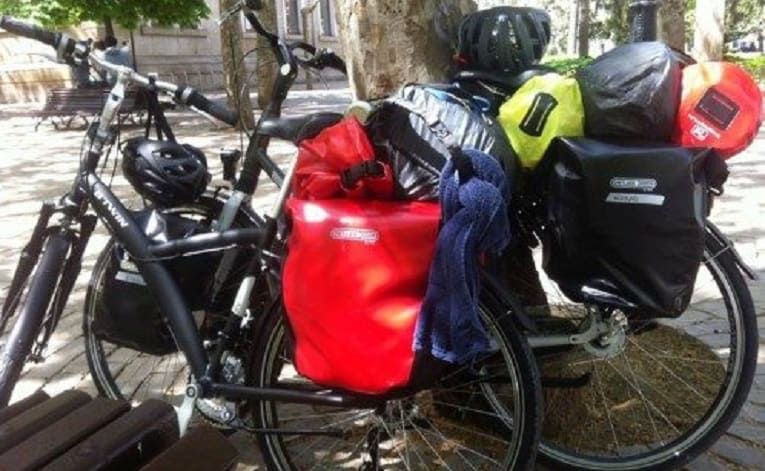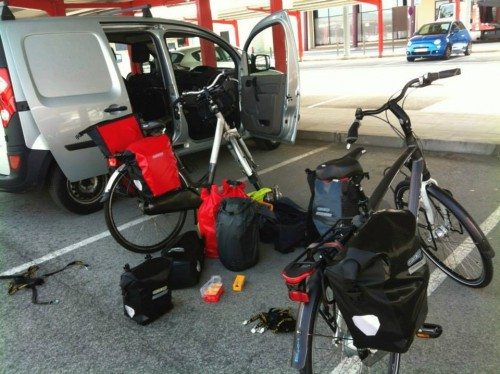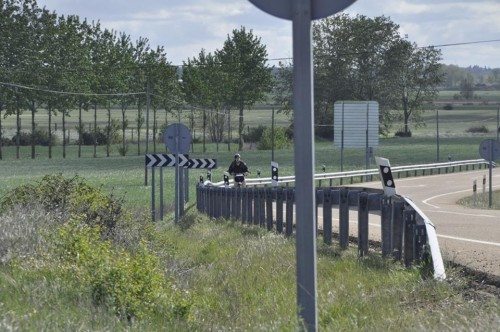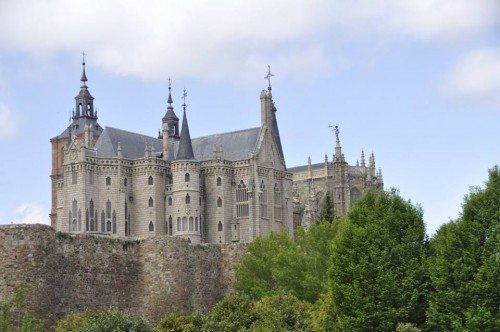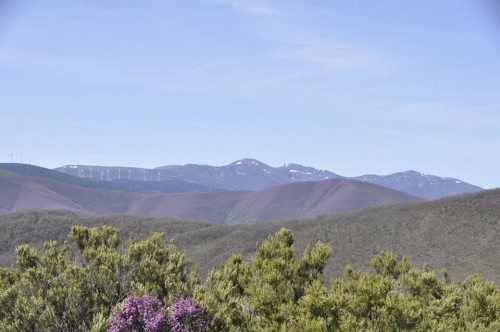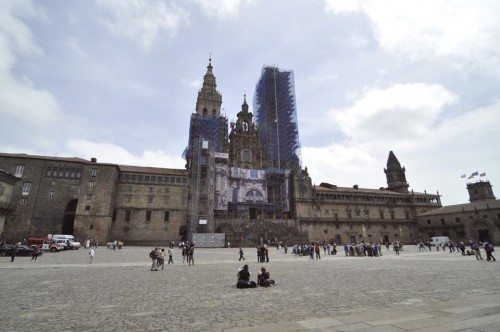My name is Ineke and I’m from The Netherlands. The idea of cycling the Camino started about two years ago. I saw the movie ‘The Way’ with Martin Sheen, and it triggered something. The idea of emptying my head and the physical challenge appealed.
I first considered walking, but that was never really an option. I’m physically challenged, there was no way that I was able to hike the Camino de Santiago with a backpack. So I started looking for other options and I came across someone who had cycled the Camino de Santiago.
She started in the Netherlands and went all the way through Belgium and France to Spain. I thought about doing that, but the journey would take too long and I couldn’t get the time off work, as had just started a new job. So I decided to start my cycle in Pamplona along with my boyfriend. The good thing was that I wouldn’t have to go through the Pyrenees. I’m sporty, I exercise a lot but I’m not a trained cyclist. So this was probably enough of a challenge.
And so we Started Planning Our Camino
We left for Spain by car on Monday the 27th of April. We had reserved long term parking at Pamplona Airport. On the 28th we drove through the Pyrenees and stopped in St. Jean Pied de Port, where we saw the first road signs for the Camino. It felt magical, it was actually happening.
We drove to the airport, put the luggage on the bikes, and took off – we started our cycle of the Camino Frances directly from the airport. After fifteen minutes my bike gave up. So there’s the first tip: Get a damn good bike. Not just a good bike, but a damn good one with a lot of gears. Seven or eight won’t be good enough. Your bike needs to be in the perfect state to carry the weight of your luggage, preferably a mountain bike. We went to Decathlon and bought a new bike.
Starting Again
On the 29th we started for the second time. Helmets are obligatory outside of the cities, which sounds logical, but we didn’t know. Luckily we had bought two at the Decathlon store. And we almost immediately understood why.
Cycling, you will be on the N-roads a lot. You are not allowed on the A-roads, but this is clearly marked. On the N roads, the traffic goes up to 100 km an hour. And you are cycling on the emergency lane or side lane. It does take some getting used to. In Holland, we have separate cycle lanes everywhere. Thankfully, most cars will allow plenty of space to pass you by.
We went from Noair to Esparza, Campanas, and Enériz to Puente la Reina, following the N111. The Camino signs are clearly marked. We passed Cirauqui and Villatuerta cycling more than 50km to Estella.
The next day we started around nine. Again, as we are beginners, we had not planned on cycling all day, we planned a minimum of 50 km a day. The way to Los Arcos is nice. It goes up and down a lot, but the downs help you get up. We kept following the N111 and passed Torres del Rio. From there, the more serious work starts climbing through the mountains.
The scenery is really beautiful and you see the walking pilgrims are close by. Still, it’s a relief when you let yourself roll down the mountain, only to go up again. But there’s plenty of space at the side of the road to get off your bike and rest. Also, they are used to bikers here, so they are careful.
We followed the way through Viana to Logrono. The way by bike will not always lead you straight through the towns and villages; you need to decide to take the detour. It would be a shame to pass them by since they are part of the experience.
From Logrono, we found it hard to find our way since we were looking for a road to follow. But the locals are very helpful. They will even give you directions when you’re not asking for them. We needed to follow the same route as the walking pilgrims.
So we just followed the walking Pilgrims. It led us to a beautiful path, which does get very rocky and steep sometimes. This eventually diverts to the road. Near Navarette, we lost our way again. You need to follow a secondary road to Huércanos, then cross the A12 by overpass only to get on the rocky road on the other side of the A12. There you will find the Camino signs again. Then you can choose. You can keep following that path to Najéra, but we took the roundabout that will be on your right after a while to get on the N120. We preferred the smoother road. This day we cycled almost 80 km, partly because we were lost for a short while.
The next day we cycled from Najéra to Santo Domingo de la Calzada. We followed the N120, but you can choose to follow the walking route as they are alongside each other. Again, we choose a smoother way.
We found the day hard going, a combination of the weather and the many ascents. So from Santo Domingo to Belorado, it was very windy, so much that we had to keep cycling when we going downhill. The road itself can be a bit boring and lonely, with the cars quite close. Maybe it would have been better on a sunny day with no wind, but this is my experience. Also, we went in April and May, so a lot of campgrounds are closed. We prefer camping to share with many others in the albergues. However, in Belorado we did sleep in one because there were no other options. The people are very nice and it’s fun to sit and talk with other pilgrims. Just the sleeping part I did not like. But I’m a light sleeper, though many people like staying in albergues. They are cheap, fun, and the meals are very affordable. This day we only cycled 48 km, due to the conditions.
The next day we cycled from Belorado to Burgos, where my boyfriend gave up. Not enough gears, heavy luggage, and not sporty combined meant he underestimated the whole thing big time. We kept following the N120, close by the walking path. We passed Villafranca, Montes de Oca, then through the Oca Mountains. At first, it’s a long climb, luckily not very steep. But still climbing for about 5 km. Then it goes up and down a lot. I actually had fun here. Again going down helps you to get up to next hill. Then after a while, it gets more even and you see the sign for Burgos. After a while, in the mountains, it’s good to have life around you again.
Another Re-Start from Bugos
We had a rest day and went and collected the car from Pamplona, as my boyfriend would now follow me by car. The positive side was that I didn’t have to carry the luggage on my bike anymore.
The next morning we discovered that my boyfriend’s bike had been stolen overnight. We had it double-locked, chained to a pole and my bike. The weird thing was that my bike was still there, without any lock whatsoever. They really wanted his Dutch bike apparently. So be careful with your stuff. It can get stolen, even when you lock it. So look for good options to leave your bike. And do insure them. We are very happy we did. With a police statement, we will get our money back, so we’re not to upset about it.
The way out of Burgos is easy, following the N120. It was really beautiful, I did love it. You’ll pass Tardajos and Quintanillas. When you reach Olmillos de Sasamón, you will follow the BU-P-4041 to Castrojeriz, on the Meseta. It’s a nice way. It’s more even and I liked the scenery, only it was very rainy. Make sure you have the means to keep your stuff dry. We bought Ortlieb-bags, and Gortex rain clothes.
Keep following the road to Fromista. Since there was no camping open there, I went on for another 20 km to Carrión de Los Condes a whopping 91 km. It’s clear that the way is more even at this part of the Camino. This area is really beautiful, there are some climbs, but it’s up and down and doable.
From Carrión de Los Condes I had to get back on the N120. It was nice as pilgrims are walking next to the road. There were a lot of other cyclists. Some of them cycled on the path where the Pilgrims were walking, but I found that unpleasant, as you have to ask them to get out of the way all the time. Annoying for the walkers as well, especially when there’s a road right next to it, which is very quiet; and the walking path is narrow.
This was an easy part, a bit up and down, but nothing I couldn’t overcome. I only cycled as far as Sahagun as I wanted the afternoon off to walk around and relax with my boyfriend. The next camping area was 45 km away, so I stopped after a little more than 50 km. Not because I was tired, but because I knew I could get to Léon tomorrow; which was 65 km away.
From Sahagun to Léon was okay, 65 km as I said. Some of it up and down, but no real heavy stuff. I stopped for lunch in Mansilla de las Mulas. I was in Léon in four hours including the time for lunch. There is one part that is tricky. When you leave Sahagun, you follow the N120, but pretty fast you need to take a right. Don’t follow the road to Gordaliza del Pino. At one point on your right, there’s an information sign of the Camino de Frances and a right turn to the A231. Now right after that turn, you’ll see, right before the curve of the N120 to the left, that the guardrail is open. There is a small track down. You need to go down there, and then you will see another secondary road to follow. I found it confusing, but that just how it is.
I took a rest day in Leon to spend time with my boyfriend and see Leon.
Then I went from Léon to Astorga, following the N120 again. The path for the hikers is right next to it. Again I preferred the smoother road, but you can follow the hiking path as well. It is pretty steep and you have to ask people to let you pass; I don’t find this ideal. You do notice that the road goes up more than the last few days because you’re getting close to the mountains again. Do note the exit on your right to Puente de Órbigo. You don’t want to miss crossing the old bridge.
In Astorga, I felt I could go on for a bit, even though it was harder after Castrillo de Los Polvazáres., mostly because of the heat. I stopped in Santa Colomba de Somoza after finding another camping that was closed. So my boyfriend took me by car to camping in Villamartin de la Abadia, with the promise to bring me back to that point tomorrow. No skipping! 67 km this day.
The next day I started in Santa Colomba de Somoza and went through the mountains. First, there’s a climb that will continue for 20 km. It’s a hard one; some parts are steeper than others. Luckily there are little cafes here and there for a break. And keep in mind after the steep climb to Cruz de Ferro you will go down for 20 km as well – and trust me, you need good brakes, as it is a very steep downhill section. You need to be careful and look out for bumps in the road. Keep at the side of the road because of cars passing you by and do watch out, because the hikers will be crossing this road as well. Do take in the wonderful scenery here, during the climb and the descent. It’s really beautiful in the spring.
You will be in Ponferrada very quickly after that. There I followed the hiking path for a while, by mistake. It was very nice, but also hard work, pretty rocky. Near Cacabelos I choose to get on the LE713 to Villafranca del Bierzo. This goes up and down a lot. After the climb I did that morning, I did find this a bit much because my legs were tired. I stopped in Villafranca del Bierzo after 70 km.
Then I had another day of rest. Because of my physical challenge, I do need to let my legs rest. But I think for a regular person it’s wise every now and then. Also, I heard that O Cebreiro would be a tough climb. So I figured it would be good to wait for a day so I’d be more ready for the challenge.
I went from Villafranca del Bierzo to Sarria this day. That’s 78 km, and it was rough. The way is very clear and easy to follow. You’re following the N-VI a pretty quiet road since most of the traffic follow the A6, but it’s hard work, climbing in the lowest gear.
After Pedrafita de Cebreiro, it gets a bit worse. I was really wondering if I could make it. Stopping for breaks wasn’t really a good idea I because it was hard to get on your bike again on that mountain. There are not really even points to stop. But when you do reach O Cebreiro, the view is amazingly beautiful. And I felt very proud that I made it.
After O Cebreiro you still have to get out of the mountains. So the climbs are not over yet. But at least you go up and down, which does bring some relief. You’re not on the N-VI anymore, but on the LU633 to Triacastela and Samos. I went on to Sarria. The road still continues to go up and down and I did find that hard because I was tired from climbing O Cebreiro. But it’s doable. You pass a lot of little towns.
That evening I thought about a rest day, probably smart, but I didn’t want to. Santiago was only 120 km away and my birthday would be the day after tomorrow. So I could reach Santiago on my birthday if I went on, and I liked that idea. So I cycled from Sarria to Melide. You stay on the LU633 until Alto del Hospital, again, up and down a lot. When you get to Alto del Hospital, you can follow the N547 but I followed the hikers on a smaller road to Mauromorto. It goes up on your right just after the roundabout.
From there I got to Palas de Rei pretty quickly. I did get a flat tire when I was close to Melide, but I was well equipped so we could fix that pretty fast. We even had spare tires, but we never needed them. Of course, Melide is on top of a hill so it was a good climb. I stopped there and camped for the night.
Cycling into Santiago de Compostela
It’s weird to start the last day of the Camino. You have been cycling the Camino Frances for two weeks and now you’re almost done. The way to Santiago de Compostela is very easy from here. Keep following the N547 or follow the hikers. They go across the country; you’ll see them a lot. They pass the same towns, but they walk on small roads.
Right before the airport, you will see signs that show you where to cycle. You will see signs that send you to a secondary road on the left on the roundabout. You will see lots of pilgrims there. Then you follow the road and go straight on the next roundabout. The way to Santiago de Compostela speaks for itself from there. You will have to make a final climb over the mountain but then you will see Santiago when you’re on top.
I felt really happy when I saw Santiago. Then it is downhill into the city and you will have to find your way through the city center to the Cathedral. It’s a pedestrian area so you will have to walk the last part. I felt wonderful when sitting in that square in front of the cathedral. Feeling very accomplished!

I love hiking, backpacking, and camping. From the Camino de Santiago to the West Highland Way in Scotland or simply a great day hike on the weekend. Hiking refreshes me, my mind, and keeps my body reasonably fit. So far I have walked three Camino routes and many other long distance hikes in the UK, Canada, and around the rest of Europe. One of the best was my hike up Ben Nevis.

